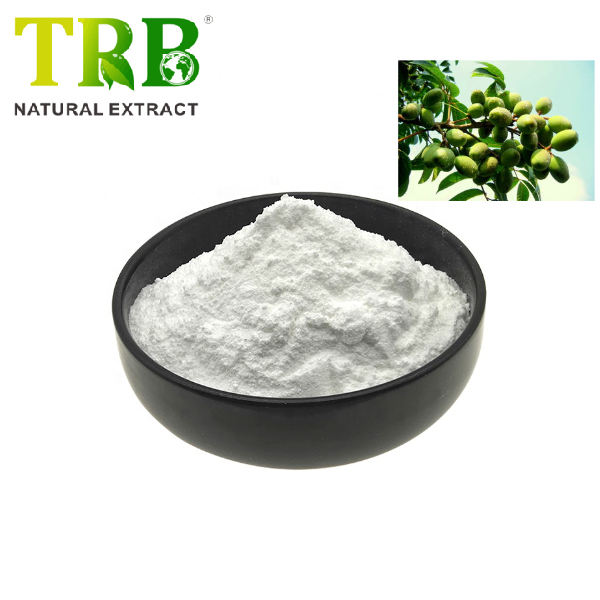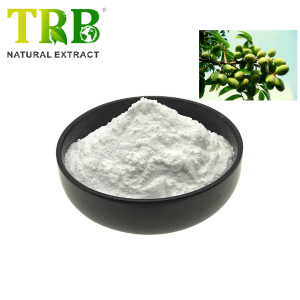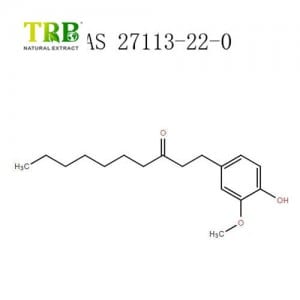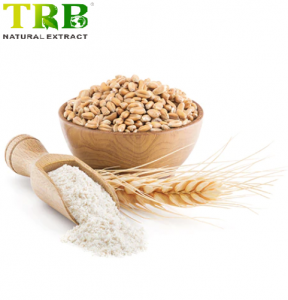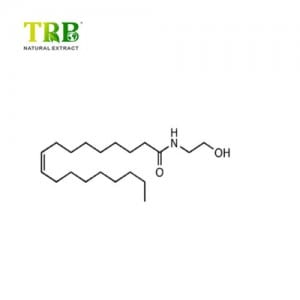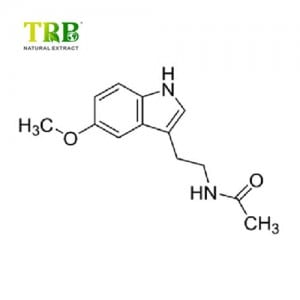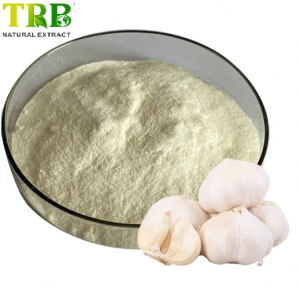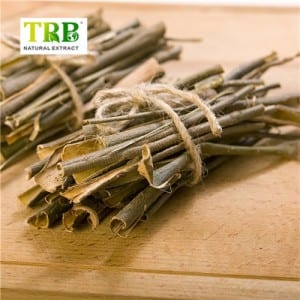Oleanolskābe, kas ir trīs pentacikliskie triterpenoīdi, kas izolēti no Swertia mileensis Gentianaceae augiem, veselas zāles vai ligustras augļiem, ar brīvu ķermeni un glikozīdiem daudzos augos.Oleanolskābes augos ir plašs klāsts, un vidējais saturs ir 0,2–2%.Cucurbitaceae augstais saturs ir 1,5% ~ kuprītis 2%, ligustras augļu saturs 0,6% ~ 0,7%.Oleanolskābe ir sava veida pentaciklisks triterpenoīds savienojums, kas izolēts no Asteraceae, Syzygium sylvestris vai Ligustrum lucidum ģints augļiem.Tas ir aknu slimības adjuvants, un to klīniski izmanto terapeitiskai infekcijai.Akūtam dzeltes hepatītam ir acīmredzama ietekme uz alanīna aminotransferāzes samazināšanos un dzeltenumu. Olskābe ir pentaciklisks triterpenoīds, kas izolēts no swertia chinensis vai fructus ligustris augļiem no gentianaceae auga.Oleanolskābe ir plaši sastopama augos, tās kopējais saturs ir 0,2–2% [1].Kalabašas dibena saturs bija 1,5% ~ 2%, bet fructus ligustris augļu saturs bija 0,6% ~ 0,7%.Oleanolskābe ir balts adatveida kristāls (etanols), bez smaržas un garšas.Nestabils pret skābēm un bāzēm.Kušanas temperatūra 308 ~ 310 ℃, [alfa] 20 d + 73,3 ° (c = 0,15, hloroforms, nešķīst ūdenī, šķīst metanolā, etanolā, etilēterī, acetonā un hloroformā. Oleanolskābe ir dabā sastopams triterpenoīds, plaši izplatīts pārtikā un ārstniecības augos, kas saistīti ar betulīnskābi. To var atrast Phytolacca americana (amerikāņu vīteņaugā), Syzygium spp.
Tika konstatēts, ka oleanolskābei ir spēcīga anti-HIV aktivitāte, betulīnskābe tika izmantota, lai izveidotu pirmo komerciālo nobriešanas inhibitoru.Vispirms tas tika pētīts un izolēts no vairākiem augiem, tostarp Rosa woodsii (lapas), Prosopis glandulosa (lapas un zari), Phordendron juniperinum (vesels augs), Syzygium claviflorum (lapas), Hyptis capitata (vesels augs) un Ternstromia gymnanthera (gaisa). daļa).Citas Syzygium sugas, tostarp java ābols (Syzygium samarangense) un rožu āboli, to satur.
Produkta nosaukums: oleanolskābe98%
Specifikācija: 98% pēc HPLC
Botāniskais avots:Olea Europea ekstrakts
Ķīmiskais nosaukums: (3β)-3-hidroksioleān-12-ēn-28-skābe
CAS Nr.:508-02-1
Izmantotā daļa: Lapa
Krāsa: balts pulveris ar raksturīgu smaržu un garšu
ĢMO statuss: Bez ĢMO
Iepakojums: 25 kg šķiedru mucās
Uzglabāšana: Neatvērtu konteineru glabāt vēsā, sausā vietā, Sargāt no spēcīgas gaismas
Derīguma termiņš: 24 mēneši no izgatavošanas datuma
Kas iroleanolskābe?
Oleanolskābe (OA), dabiska hidroksilpentacikliskā triterpenoīda skābe (HPTA), kas līdzīga betulīnskābei, ursolskābei;tai ir tādas priekšrocības kā antibakteriāla, pretiekaisuma un pretvēža iedarbība.

Kur var atrastoleanolskābe?
Oleanolskābe tradicionāli tiek izmantota dažādu slimību ārstēšanai, to plaši var atrast pārtikā un augos.
Daži augļi, piemēram, āboli, granātāboli, citroni, mellenes, olīvas, satur arī oleanolskābi.

| Garšaugu nosaukums | Oleanolskābes saturs | Pārbaudes metode |
| Ligustrum lucidum Ait | 0,8028% | HPLC |
| Verbena Officinalis L | 0,071–0,086% | HPLC |
| Prunella vulgaris L | 3,47–4,46% | HPLC |
| Hemsley Chinensis Cogn. | 1,5–2% | HPLC |
Pašlaik ķīniešu garšaugsHemsley Chinensis Cognjoprojām ir viskomerciālākā izejviela oleanolskābes ekstrakcijai.
Hemsley Chinensis Cogn.Ievads
Hemsleya chinensis Cogn.ir daudzgadīgs kāpšanas augs, kā arī tradicionālā ķīniešu medicīna.
Ģimene: Cucurbitaceae
Tribuss: Gomphogyneae
Ģints: Hemsleya
Suga: H. amabilis
Garšaugs tiek izplatīts provincēs Guangxi, Sichuan, Guizhou, Yunnan, Hubei uc Dzimis mežmalā un ielejas krūmos aptuveni 2000 metru augstumā.
Aktīvās sastāvdaļas: satur Hemslolide Mal、Ma3、H1;Čikusetsusaponīns-Iva;dihidrocucurbitacin F-25-acetāts;dilydrocucurbitacin F;oleanolskābes-beta-hlikoziloleanolāts;hemsamabilinīns A;Cu-curbitacinⅡb-2-beta-D-glikopiranozīds.
Ārstnieciskās vērtības:
Hemsleya chinensis Cogn.galvenokārt paredzēts detoksikācijai, sterilizācijai, pretiekaisuma, kuņģa stiprināšanai un sāpju mazināšanai.Pašlaik klīniskajā praksē plaši tiek izmantoti ekstrakti, pulveris vai salikti preparāti, piemēram, kapsulas, tabletes, kuņģa-zarnu trakta tabletes utt.

Oleanolskābes ekstrakcija noHemsleya Chinensis Cogn.

Oleanolskābi saturošas formulas uztura bagātinātājos
Mēs atklājām, ka oleanolskābe, ko izmanto veselības piedevās, galvenokārt nāk no trīs veidu augu ekstraktiem: Loquat lapu ekstrakts, Hemsley Chinensis ekstrakts un svētā bazilika ekstrakts.
- Svētā bazilika pulveris (lapas) (0,4% ursolskābe un oleanolskābe, 2,0 mg)
- Svētā bazilika superkritiskais CO2 ekstrakts (lapa) (Ocimum tenuiflorum Linn.) (2,5% ursolskābe un oleanolskābe, 1,5 mg)
- Loquat ekstrakts (augļi) (nodrošina ursolskābi, oleanolskābi) (standartēts līdz ursolskābei uz porciju 125 mg)

Oleanolskābe VS Ursolskābe
Oleanolskābe (OA) un ursolskābe (UA) ir dabiski triterpenoīdi, kuriem ir līdzīga ķīmiskā struktūra.
Ir zināms, ka šie triterpenoīdu savienojumi pastāv ārstniecības augos un pārtikas produktos.
Tiem ir daudz kopīgu farmakoloģisku īpašību: hepatoprotektīvas, pretiekaisuma, pretmikrobu, hipoglikēmiskas, antimutagēnas, anti-HIV aktivitātes, antioksidanta un pretauglības aktivitātes.

OA un UA atšķirība:
| produkta nosaukums | Oleanolskābe | Ursolskābe |
| CAS NR. | 508-02-1 | 77-52-1 |
| Pentacikliskie triterpēni | β-Amirīns | α-Amirīns |
| Garšaugu avoti | Loquat lapas, svētais baziliks, rozmarīns, olīvu lapa utt. | |
| Specifikācijas | 40%, 98% pulveris | 15%, 25%, 50%, 98% pulveris |
| Izskats (krāsa un smarža) | 40% gaiši dzeltens98% balts pulveris bez smaržas | 15%-50% brūni dzeltens vai dzeltens98%balts pulveris Raksturīgs |
| Atšķirīga | IR: (1355 ~ 1392 cm-1) divi maksimumi (1245 ~ 1330 cm-1) trīs maksimumi NMR: δ (C12)122,1,δ(C13)143.4 | (1355 ~ 1392 cm-1) trīs virsotnes (1245–1330 cm).-1) trīs virsotnesδ(C12)125,5,δ(C13)138,0 |
| Atvasinājumi | Oleanolskābes nātrija sāls Oleanolskābes dinātrija fosfāta sāls3-oksooleanolskābe bardoksolona metils (CDDO-Me) | Urzolskābes nātrija sāls un tā dikarbonskābes pusestera atvasinājumi Ursolskābes ketēna atvasinājumi 3 oglekļa ursolskābe 3-acetoksiursolskābe |
| Potenciāls pretvēža līdzeklis | UA ir populārāka nekā OA. | |
Oleanolskābes bioloģiskās aktivitātes
-
Pretaudzēju/pretvēža iedarbība
Oleanolskābes inhibējošā iedarbība uz hepatocelulāro karcinomu, izmantojot ERK-p53 mediētu šūnu cikla apstāšanos un no mitohondriju atkarīgu apoptozi
– Xin Wang, Hua Bai uc Pētnieki
OA uzrādīja inhibējošu iedarbību uz HCC, inducējot apoptozi un šūnu cikla apstāšanos gan transplantētos audzējos, gan HepG2 šūnās.
OA izraisīja apoptozi caur mitohondriju ceļu, par ko liecina rapamicīna ceļa Akt / zīdītāju mērķa inhibīcija.
OA izraisīta G2/M šūnu cikla apstāšanās, izmantojot p21 mediētu ciklīna B1/cdc2 pazeminātu regulēšanu.
OA demonstrēja ievērojamas pretvēža aktivitātes HCC in vivo un in vitro modeļos.Šie dati sniedz jaunu ieskatu mehānismos, kas ir OA pretvēža iedarbības pamatā.
Turklāt pētījumi liecina, ka OA un tā atvasinājums oleanolskābes metilesteris ietekmē arī krūts vēzi, plaušu vēzi, urīnpūšļa vēzi, dzemdes kakla vēzi, aizkuņģa dziedzera vēža šūnas…

-
Pretmikrobu darbība
Paredzams, ka OA būs pretmikrobu iedarbība pret plašu patogēnu klāstu, jo tai ir būtiska loma aizsardzībā pret patogēniem augos.
OA uzrādīja mērenu aktivitāti pret Staphylococcus aureus un Bacillus Thuringiensis pie 62,5 µg/ml un Escherichia coli, Salmonella Enterica un Shigella dysenteriae pie 31,2 µg/ml minimālās inhibējošās koncentrācijas (MIC).
-
Hepatoprotektīva spēja
Viena no ievērojamākajām OA bioaktivitātēm ir aknu aizsardzība pret toksicitāti, un pašlaik to Ķīnā izmanto kā bezrecepšu zāles pret aknām.
Wistar albīnu žurkām tika izmantots Flaveria Trinervia OA, un tam bija ievērojama aizsargājoša iedarbība uz etanola izraisītu aknu toksicitāti, atjaunojot hepatotoksisko seruma marķiera enzīmu līmeni.Šis pētījums ierosināja OA antioksidantu spēju kā vēl vienu iespējamu tā hepatoprotektīvo spēju mehānismu.
Oleanolskābe un tās atvasinājumi

Oleanolskābes klīniskie pētījumi
Oleanolskābe (iegūta no olīvām), ir aptuveni 500 reģistrētu klīnisko pētījumu, un tas parādīja labvēlīgu ietekmi klīniskajos pētījumos par hronisku nieru slimību, 2. tipa cukura diabētu un dažiem iekaisuma stāvokļiem, piemēram, artrītu.
Klīniskajos pētījumos populārākie atvasinājumi ir bardoksolona metils (CDDO-Me).CDDO-Me tika novērtēts audzēju biopsijās, un tam varētu būt nozīme hroniskas nieru slimības ārstēšanā, pašlaik tiek novērtēta tā ietekme uz hipertensiju.
Ķīniešu farmakopejas oleanolskābes standarts
| Produkta nosaukums | Oleanolskābe |
| Identifikācija | (1) Paņemiet 30 mg šī produkta, ievietojiet to mēģenē, pievienojiet 3 ml hloroforma, lai izšķīdinātu, pievienojiet divus pilienus sērskābes, sakratiet 5 minūtes, hloroforma slānis ir purpursarkans. |
| (2) Paņemiet apmēram 20 mg šī produkta, pievienojiet 1 ml etiķskābes anhidrīda, izšķīdiniet to ar nelielu karstumu, pievienojiet sērskābi purpursarkanai krāsai un pēc ievietošanas padariet to tumšāku. | |
| (3) Ņem apmēram 10 mg šī produkta, pievieno vanilīna ledus etiķskābes šķīdumu (ņem vanilīnu 0,5 g, pievieno 10 ml ledus etiķskābes, lai izšķīdinātu, tas ir) 0,2 ml, pievieno 0,8 ml perhlorskābes un karsē vairākas minūtes. ūdens vannā.Fuksija, pievieno 2 ml etilacetāta, purpursarkanā, izšķīdināta etilacetātā, novietota bez krāsas maiņas. | |
| (4) Šā izstrādājuma infrasarkanās absorbcijas spektram jāatbilst kontroles spektram. | |
| Testa noteikšana | Ņem 0,15 g šī produkta, precīzi nosver, pievieno 30 ml etanola, sakrata, karsē siltā ūdens vannā, lai izšķīst, ļauj atdzist līdz istabas temperatūrai, pievieno 3 pilienus fenolftaleīna indikatora šķīduma, pagatavo kālija hidroksīda šķīdumu ar etanolu ( 0,05 mol/L) Nekavējoties titrē un koriģē tukšo testu.Kālija hidroksīda šķīdums (0,05 mol/L) uz 1 ml etanola atbilst 22,84 mg C30H48O3. |
Oleanolskābe ieteicamā deva
Saskaņā ar Ķīnas farmakopejas standartu oleanolskābes perorālā deva ir 20–80 mg dienā, 60–240 mg dienā.
Oleanolskābes blakusparādības
Oleanolskābe Ķīnā gadu desmitiem izmantota kā bezrecepšu (OTC) hepatoprotektīvs līdzeklis.
Pārdozēšanas vai nepareizas lietošanas gadījumā nelielam skaitam pacientu ir sausa mute, caureja, diskomforta sajūta vēdera augšdaļā un var izzust pēc simptomātiskas ārstēšanas.
Pirms šī produkta lietošanas konsultējieties ar savu ārstu vai farmaceitu.
Funkcija:
1. Oleanolskābe ir salīdzinoši netoksiska, pretaudzēju un hepatoprotektīva, kā arī tai piemīt pretvīrusu īpašības.
2. Tika konstatēts, ka oleanolskābei ir spēcīga anti-HIV aktivitāte.
3.Oleanolskābe ir galvenais šūnu aizsargs pret oksidatīvo un elektrofilo stresu.
4.Oleanolskābei ir lieliska ietekme uz vīrusu hepatītu, akūtu ikterisku hepatītu un hronisku hepatītu.
Pielietojums:
1. Lieto pārtikas jomā, tas var darboties kā tējas izejvielas, lai samazinātu flegmu;
2. Lieto farmācijas jomā, tas kļūst par jaunu pretvēža līdzekli ar zemu toksiskumu;
3. Lieto kosmētikas jomā, tas var stimulēt asinsriti un noņemt dzērienu.
| Vairāk informācijas par TRB | ||
| Noteikumu sertifikācija | ||
| USFDA, CEP, KOSHER HALAL GMP ISO sertifikāti | ||
| Uzticama kvalitāte | ||
| Gandrīz 20 gadus eksportē 40 valstis un reģionus, vairāk nekā 2000 TRB ražotajām partijām nav nekādu kvalitātes problēmu, unikāls attīrīšanas process, piemaisījumu un tīrības kontrole atbilst USP, EP un CP. | ||
| Visaptveroša kvalitātes sistēma | ||
|
| ▲Kvalitātes nodrošināšanas sistēma | √ |
| ▲ Dokumentu kontrole | √ | |
| ▲ Validācijas sistēma | √ | |
| ▲ Apmācību sistēma | √ | |
| ▲ Iekšējā audita protokols | √ | |
| ▲ Papildinātāja audita sistēma | √ | |
| ▲ Aprīkojuma iekārtu sistēma | √ | |
| ▲ Materiālu kontroles sistēma | √ | |
| ▲ Ražošanas kontroles sistēma | √ | |
| ▲ Iepakojuma marķēšanas sistēma | √ | |
| ▲ Laboratorijas kontroles sistēma | √ | |
| ▲ Verifikācijas validācijas sistēma | √ | |
| ▲ Regulēšanas lietu sistēma | √ | |
| Kontrolējiet visus avotus un procesus | ||
| Stingri kontrolētas visas izejvielas, aksesuāri un iepakojuma materiāli. Vēlamais izejvielu un piederumu un iepakojuma materiālu piegādātājs ar ASV DMF numuru. Vairāki izejvielu piegādātāji kā piegādes garantija. | ||
| Atbalstāmas spēcīgas kooperatīvās institūcijas | ||
| Botānikas institūts/Mikrobioloģijas institūts/Zinātņu un tehnoloģiju akadēmija/Universitāte | ||
